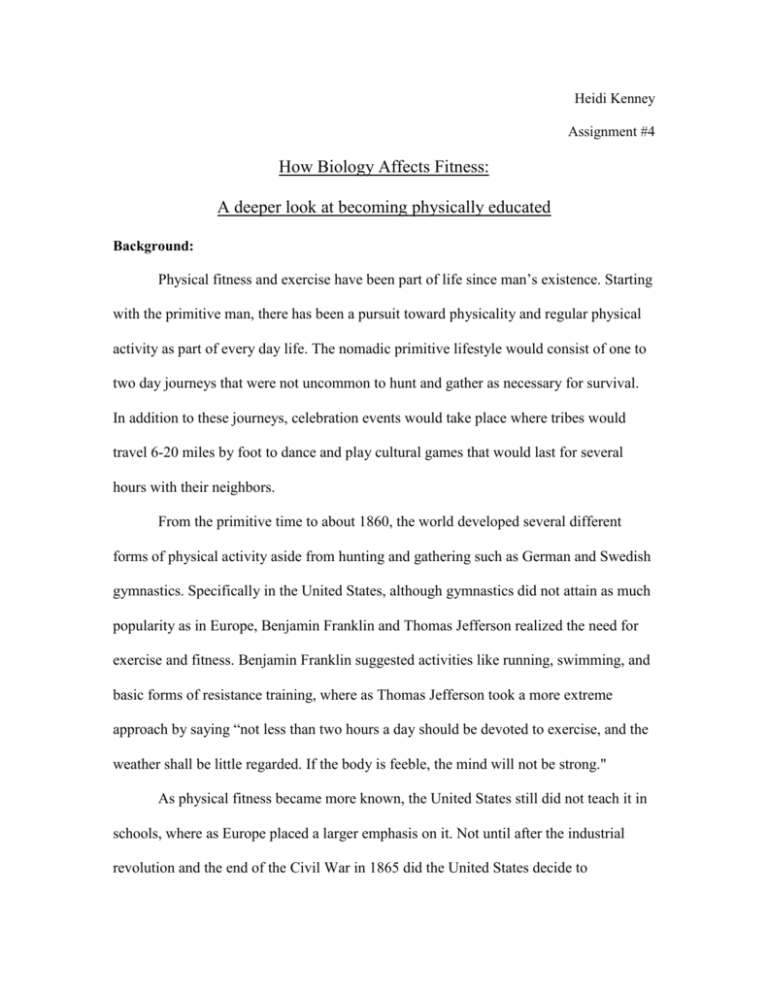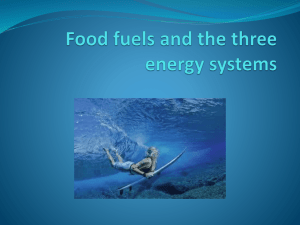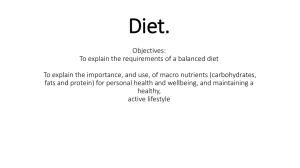Heidi Kenneybiology
advertisement

Heidi Kenney Assignment #4 How Biology Affects Fitness: A deeper look at becoming physically educated Background: Physical fitness and exercise have been part of life since man’s existence. Starting with the primitive man, there has been a pursuit toward physicality and regular physical activity as part of every day life. The nomadic primitive lifestyle would consist of one to two day journeys that were not uncommon to hunt and gather as necessary for survival. In addition to these journeys, celebration events would take place where tribes would travel 6-20 miles by foot to dance and play cultural games that would last for several hours with their neighbors. From the primitive time to about 1860, the world developed several different forms of physical activity aside from hunting and gathering such as German and Swedish gymnastics. Specifically in the United States, although gymnastics did not attain as much popularity as in Europe, Benjamin Franklin and Thomas Jefferson realized the need for exercise and fitness. Benjamin Franklin suggested activities like running, swimming, and basic forms of resistance training, where as Thomas Jefferson took a more extreme approach by saying “not less than two hours a day should be devoted to exercise, and the weather shall be little regarded. If the body is feeble, the mind will not be strong." As physical fitness became more known, the United States still did not teach it in schools, where as Europe placed a larger emphasis on it. Not until after the industrial revolution and the end of the Civil War in 1865 did the United States decide to implement physical education, but only in regards to sports and games. From the 20Th century and on, the United States became more aware of the need for physical education and implementing an exercise routine daily through presidential influences and the effects of war. However, such influences have not made much of a difference today. Current research findings: In the United States today, fifty-nine million U.S. adults are obese. Over the past 10 years, obesity has increased 60 percent among U.S. adults. Sixteen percent of U.S. children and adolescents age 6-19 are overweight. Since 1980, being overweight has doubled for children and tripled for adolescents (National Conference of State Legislatures). In order for people to grow into healthy adults, they must first learn about fitness at a young age. We need exercise not only to maintain a healthy body weight, but to help our cardio respiratory systems and prevent morbidity diseases such as heart disease or diabetes. A 2-year nationwide study of 8,800 students in grades 5 through 12 determined that as many as half are not developing the exercise and fitness skills that will help maintain good health as an adult. Nor are they getting enough exercise to develop healthy cardio respiratory systems. The study also determined that approximately 80 percent of 5th through 12th graders take a physical education class. However, enrollment declines, with 98 percent enrolled in 5th grade, and barely 50 percent in 12th grade (the Public Health Service’s Office of Disease Prevention and Health Promotion). Although students are attending physical education classes, they are not learning the lifetime fitness skills that are essential to achieve optimal health as an adult. Physical education teachers of young students tend to rely on relays and informal games, such as dodgeball and kickball. Among older students, teachers rely on competitive sports and other activities that can not readily be practiced by adults. Moreover, if we would put more focus on the actual education of the subject, even in a biological sense than the actual activity, that may be more beneficial in the long run. Relevance: The body is a fascinating thing and understanding the biology of how exercise affects it can be beneficial. Our body needs nutrients to perform exercise and give it the fuel that it needs to function. The three contributors that can be converted to energy are carbohydrates, fats, and proteins. These nutrients are converted to energy in the form of adenosine triphosphate or ATP. Muscle cells are able to contract because of the energy that is released and the breakdown of ATP. Although these nutrients work together, they all have unique properties that determine how it is converted to ATP or how it functions in the body. First and foremost, there is the carbohydrate. A carbohydrate is an organic compound and the main nutrient that fuels exercise of moderate to high intensity. When carbohydrates are eaten, they are broken down into smaller sugars such as glucose, fructose, and galactose that are absorbed and used for energy. The glucose that is not needed and used right away is stored in the muscles and the liver in the form of glycogen. Glycogen is the most often used energy source during intense exercise because it is immediately accessible. During slow durations of exercise, fat is more helpful than carbohydrates in fueling such activity. However, glycogen is still needed to help break down fat into something that the muscle can use. Fats as well as carbohydrates are often looked at as detriments when it comes to losing weight or becoming fit. On the contrary, both nutrients are essential for optimal health. Adipose tissue which is stored fat, provides insulation and cushion to our internal organs, covers our nerves, moves vitamins throughout our body and is the largest reserve of energy storage to perform activity. Fat is stored when we consume more calories than we use. One gram of fat is equal to nine calories where as one pound of stored fat provides 3,600 calories of energy. Although fats store a large amount of energy, it takes time for the body to breakdown the fat to use it for energy. Therefore when consuming fat, make sure it is the right kind of fat and be aware of how much is consumed. Fats and carbohydrates are the most common forms of nutrients that are converted into energy; however protein is also an essential nutrient during exercise. All three nutrients work together to fuel the body. An adequate amount of carbohydrates need to be consumed to help prevent protein from being used as energy. If there are not enough carbohydrates consumed, protein is broken down to make glucose to use as energy. Relying on protein to be used for energy can limit the ability to build and maintain tissues. Instead, we need to use protein as the building blocks of the body. Protein consists of a combination of structures called amino acids that combine in various ways to make muscles, bone, tendons, skin, hair, and other tissues. In addition to making tissues, proteins function to provide nutrient transportation and enzyme production. They also repair and rebuild muscle that is broken down during exercise to help carbohydrate storage in the form of glycogen. As stated before, not getting enough carbohydrates will result in protein being used for energy during exercise. However, protein can be used when a diet lacks adequate carbohydrates for fuel, it is just not ideal as there will not be enough protein to repair and rebuild body tissue. Proteins are also not easily stored in the body, therefore it is important to get regular and adequate intake of protein daily. As our body converts these nutrients to fuel and other functions, it relies on energy pathways to produce a continuous amount of ATP during exercise. That continuous amount of ATP is necessary because the body can not easily store ATP and what is stored is used up within seconds. The two major ways the body converts nutrients to energy are anaerobic, meaning without oxygen, and aerobic, meaning with oxygen, metabolisms. The duration and the intensity of the workout will determine which method gets used. To understand both pathways, first there is the understanding of the ATP-CP anaerobic energy pathway. This pathway does not require oxygen to create ATP and supplies about 10 seconds worth of energy to be used for short bursts of exercise such as sprinting. First the stored ATP in the muscle is used up. Then it uses creatine phosphate or CP to re-synthesize ATP until the CP runs out. After both ATP and CP are used up, the body will move either to aerobic or anaerobic metabolism to continue creating ATP to fuel exercise. Anaerobic metabolism also known as glycolysis uses specifically carbohydrates to form ATP. The breakdown of glucose does not need oxygen during this process and it produces energy for short, high-intensity bursts of activity that do not last more than a few minutes. Aerobic metabolism fuels most of the energy needed for a long duration activity. During aerobic metabolism, oxygen is used to convert carbohydrates, fats, and proteins into ATP. This process is slower than anaerobic metabolism because the circulatory system is relied upon to transport oxygen to the working muscles before it creates ATP. Both pathways should be used during exercise to maintain the constant production of energy to fuel the body while exercising. Personally I think that it is important to exercise and maintain a healthy diet. In my own experience, I have been obese most of my life. Not until after I turned 20 did I learn more about nutrition and how it can affect my body. I started a regular fitness program for myself and am completely aware of the nutrients I give my body. I think that it is important for us to learn at a young age not only that exercise by itself is important, but gain a complete understanding of why it is important and how our body is affected in the process. Bibliography Background: www.unm.edu Current Research: www.ncsl.org www.cdc.gov www.ncbi.nlm.nih.gov Relevance: “Concepts of Biology” www.sportsmedicine.com







